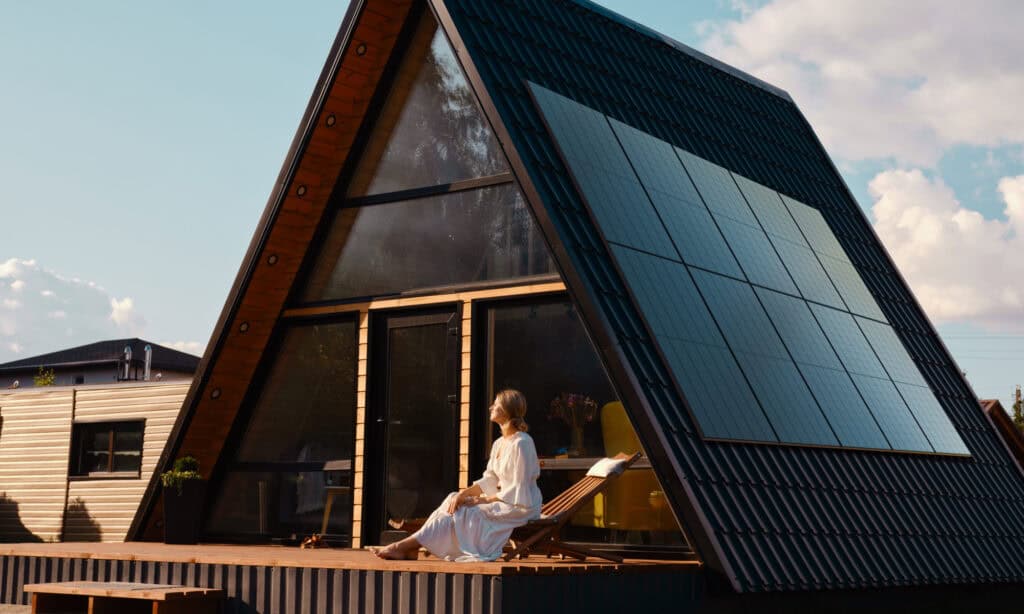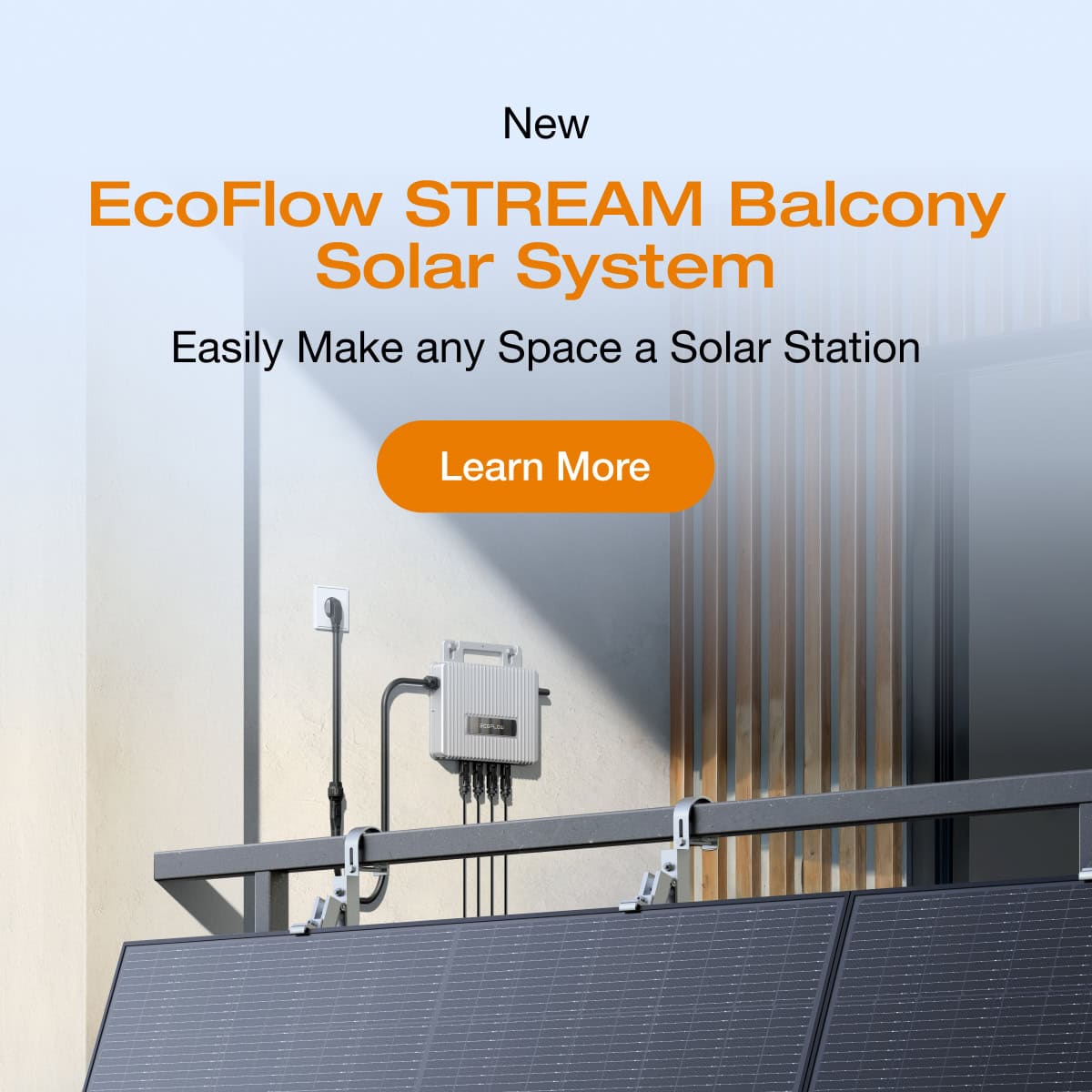Table of Contents
Human-made climate change has made the transition to clean, renewable sources of energy a global priority.
Net UK territorial greenhouse gas emissions by TES sector, 2023 (%)
Recent figures from the Dept. of Energy Security and Net Zero show that 11% of the UK’s greenhouse gas emissions come from electricity production.
If you’re considering switching some or all of your home electricity supply to solar, you need to know about solar batteries.
You’ve come to the right place.
What Is a Solar Battery?
One of the biggest obstacles to the mass adoption of renewable energy sources like wind and solar is intermittency.
Solar panels don’t work at night.
Wind turbines don’t generate electricity on still days.
One solution to the challenge of intermittency is to connect renewable power solutions like solar panels and a balance of system directly to the National grid.
Multiple government incentives — including the Smart Export Guarantee (SEG) and solar panel grants — support on-grid residential solar power systems.
However, it’s essential to note:
Grid-tied residential solar power systems DO NOT supply electricity during blackouts or extended power outages.
On-grid systems without solar battery storage must include an auto-shutdown switch to take them offline for the duration of any outage.
Shutdown is required to protect technicians who may be working to restore power and to prevent further damage to the power grid.
Off-grid and hybrid (solar + storage) photovoltaic (PV) systems rely on solar battery storage to provide electricity with or without a connection to the grid.
Many homeowners concerned with energy security and the increased frequency of extreme weather events opt for off-grid or hybrid systems like EcoFlow PowerOcean that supply power during blackouts.
Even if you already have a grid-tied system, you can retrofit solar battery storage for your home.
How Do Solar Batteries Work?
Just like rechargeable mobile phones or laptops, solar batteries store direct current (DC) electricity supplied by a power source for later use.
The fundamental principle behind all types of rechargeable batteries — including solar power storage — is the same.
At least one electrochemical cell accumulates and stores energy as DC electricity.
Through a reversible electrochemical reaction, battery cells output power on demand until storage capacity is exhausted or the battery is recharged.
The chemical and mechanical composition of batteries varies significantly and is the primary method used to categorize batteries into types, such as lead-acid and lithium ion.
Most consumer-grade rechargeable batteries are topped up by plugging into a household (AC) electricity outlet, but solar batteries store energy captured from sunlight using the photovoltaic effect.
When your consumption exceeds the amount of power the PV module array generates, the solar battery steps in to meet your electricity needs.
Depending on the type of solar generator or other balance of system you purchase, you can plug your home appliances and electronic devices directly into the portable power station.
Or you can integrate your solar panels and battery with your home circuitry using a Smart Home Panel or transfer switch.
Off-grid and hybrid residential solar power systems require battery storage to function, as well as additional balance of system components.
Here are the required components for home PV systems.
- Photovoltaic modules (such as solar panels or shingles)
- Solar inverter
- Solar battery*
- Charge controller*
- Battery management system*
- Storage inverter*
- Transfer switch (if integrating with home wiring)
- Cables and wiring
* not required in grid-tied systems
It’s possible to mix and match parts from different manufacturers, but proceed with caution as this frequently leads to compatibility issues.
Many consumers prefer an all-in-one, plug-and-play solution like EcoFlow’s DELTA Pro 3 for its simplicity, expandability, and outstanding performance.
What Are the Different Types of Solar Battery Storage?
Solar batteries come in all shapes and sizes, but the primary distinguishing factor between them comes down to chemistry.
The first rechargeable battery chemistry ever invented was lead-acid, way back in 1859.
For most of the 20th century, lead-acid and nickel-cadmium batteries were the only rechargeable options for consumers.
In the early 1990s, the first lithium-ion (Li-ion) rechargeable batteries were introduced and quickly became the chemistry of choice for portable electronic devices.
Today, newer subsets of Li-ion battery chemistry — like lithium iron phosphate (LiFePO4/LFP) — have become the go-to choice for residential solar power systems and EVs.
So, what are the different types of solar batteries?
Here’s a summary, or click the link above for a more detailed look.
Lithium-Ion Batteries
If you’re reading this article on your mobile, tablet, or laptop, you’re familiar with Li-ion rechargeable batteries — whether you know it or not.
Thanks to their high energy density and performance, lithium-ion has long been the industry standard for portable electronics.
Many devices we’ve grown to depend on would be impractical without Li-ion batteries.
All lithium-ion battery types consist of variations on three essential components:
- Anode (typically carbon)
- Electrolyte (lithium salt in an organic solvent)
- Cathode (varies by type)
Recent subsets of Li-ion battery chemistry—like lithium iron phosphate (LFP/LiFePO4) and lithium nickel manganese cobalt oxides (NMC)—are named for the materials used in the cathode.
LFP batteries are increasingly becoming the top choice for high-capacity energy storage applications, such as electric vehicles and solar batteries.
Lithium Iron Phosphate
LFP/LiFePO4 is a newer subcategory of Li-on battery chemistry that offers numerous advantages over traditional lithium-ion batteries.
From a technical perspective, the main difference between LFP and Li-ion batteries is the chemical composition of the cathode.
Conventional Li-ion batteries use a cathode made from lithium cobalt oxide (LiCoO2), while the cathode in LFP batteries is made from lithium, iron, and phosphate
Both battery types use lithium salt as electrolytes and carbon for the anode.
When combined in a battery cell, the cathode, anode, and electrolyte solution is able to store and output DC electricity.
The main performance advantages of LFP solar batteries over traditional Li-on include:
- Safety: Less prone to overheating. Eliminates potential for thermal runaway
- Wider Operating Temperature Range
- Greater Cycle Life (Lifespan/Longevity)
- Higher Depth of Discharge (DoD)
- Lower Self-Discharge Rate
In addition to the numerous performance enhancements LFP offers over conventional Li-ion batteries, there are also humanitarian benefits.
Lithium-ion — and subtypes like NMC — require cobalt to function.
Unfortunately, 70% of the world’s cobalt is mined under brutal labour conditions in the Democratic Republic of Congo (DRC), leading the metal to be labelled as blood cobalt
Cobalt extraction is the subject of multiple harrowing exposes and documentaries.
LFP batteries don’t use cobalt or nickel — more on nickel below.
Nickel Manganese Cobalt (NMC/NCM)
NMC solar batteries are another recent Li-ion-type variant that offers several advantages over conventional lithium batteries.
Unfortunately, NCM batteries use nickel and cobalt as cathode materials, both rare metals that are costly to extract and that LFP batteries don’t require.
NMC is the older, more established technology for applications that require high energy density, like electric vehicles (EVs)
However, EV manufacturers worldwide are increasingly switching to LFP, bringing the price of LiFePO4 and NCM batteries to about par.
Industry-leading solar battery manufacturers like EcoFlow use LFP batteries exclusively in their current range of portable power stations and solar generators.
Lead-Acid Batteries
Sealed Lead Acid/Valve Regulated Lead Acid (SLA/VRLA)
Often marketed as deep cycle batteries, sealed lead acid solar batteries represented a significant upgrade on conventional flooded lead acid when first released.
However, Li-ion types like LFP offer much better cycle life, depth of discharge, and performance.
The one area where SLA batteries may still offer a slight advantage is price, but increasingly, that’s no longer the case.
VRLA batteries fall under two different types:
- Absorbent Glass Mat (AGM)
- Gel Cell
Like traditional lead-acid, SLA batteries use lead plates as electrodes and diluted sulfuric acid as the electrolyte solution.
AGM and gel cell battery construction reduces electrolytic volatility and improves performance, resulting in a higher depth of discharge and longer cycle life.
Nickel Cadmium (Ni-Cd) Batteries
After lead acid, nickel-cadmium was the second rechargeable battery technology to see widespread adoption, particularly in portable devices like power tools.
However, ni-cad batteries have been far superseded by li-ion in performance and are no longer a viable option for new residential solar power systems.
Additionally, the disposal of cadmium – a primary material used in NiCd batteries — has a devastating impact on the environment, the food chain, and human health.
The European Union (EU) began banning the manufacture of NiCd batteries in 2006, and NiCd batteries can now only be used in limited applications under stringent manufacturing, disposal, and recycling regulations.
Flow Batteries and Other Emerging Technologies
As global demand for energy storage continues to grow, so does the race to innovate new and better battery chemistry and technology.
The following chemistries have shown some promise but are likely years away from adoption in consumer applications.
Building large-scale battery factories is extremely expensive.
For example, the LiFePO4 gigafactory that recently broke ground in Tucson, Arizona, is expected to cost $1.2B and occupy 267 acres of land.
Given the current low prices for lithium and other raw materials, manufacturers have little incentive to adopt unproven technologies that may only offer marginal gains in performance.
Lithium-ion and lead-acid continue to dominate the rechargeable battery market and will likely do so for the foreseeable future.
What Are the Benefits of Solar Battery Storage?
Purchasing an off-grid or hybrid solar panel system has many advantages over opting for a grid-tied setup.
It will cost you more upfront, but over time, it’s more than worth the additional price.
Many homeowners with existing photovoltaic systems are now retrofitting them with home backup batteries to reap the additional benefits of solar storage.
So what are the benefits?
Read on to find out.
Energy Security
The appeal of grid-tied solar power systems is easy to understand.
They cost less upfront than off-grid and hybrid photovoltaic systems because they don’t require a solar battery and additional components like a charge controller and storage inverter.
However, forgoing storage means you won’t have power during a blackout.
Grid-connected photovoltaic systems automatically shut down and stay offline during power outages to protect technicians and infrastructure.
Off-grid and hybrid solar panel systems eliminate dependence on the National grid and help ensure your family’s energy security during even extended blackouts.
Electricity Bill Savings
No matter how many PV modules you add to a grid-tied residential solar panel system, you’ll always rely on the power company for electricity during the night and when your household consumption exceeds production.
You can certainly save money on electricity bills with an on-grid system, but you can’t eliminate them completely or maximise savings without solar battery storage.
Depending on the type of off-grid or hybrid photovoltaic system you purchase, you may be able to take advantage of Time of Use pricing by only using grid power during off-peak hours.
For example, EcoFlow’s solar generators — like DELTA Pro 3 — allow you to maximise savings by programming the system to only use on-peak power when absolutely necessary.
Additionally, all of EcoFlow’s portable power stations can be controlled and monitored remotely from anywhere with an internet connection via the EcoFlow App for Android and iOS.
Solar Payback and Return On Investment
Purchasing the right home solar power system can provide a significant return on investment, but it’s not a get-rich-quick proposition.
When evaluating the financial benefits of investing in solar, thinking mid-to-longterm is essential.
After all, high-performance PV modules like EcoFlow’s rigid solar panels can last over three decades before needing to be replaced.
Grid-tied systems can be superficially appealing because of the lower initial cost.
However, even if you’re eligible to feed-in through the Smart Export Guarantee program, you’ll likely realise a better return on investment over time by opting for off-grid or hybrid solar power.
The best way to evaluate investment potential is to determine your solar payback period.
In short, once your electricity bill savings exceed the cost of your system, you’ve achieved solar payback, and any additional savings represent your return on investment.
After all, money saved is money earned.
Because solar battery storage helps you save more money on power bills over time—as well as offering greater energy independence—it typically provides a higher return on investment.
Cleaner Power
If lowering your family’s carbon footprint is part of your reason for switching to solar, opting for an off-grid or hybrid system with battery storage will help achieve your goals.
All grid-tied systems rely on electricity from the National grid to function.
Unfortunately, power companies still rely on fossil fuels to generate much of the UK’s power.
Significant strides have been made in electricity generation from renewable energy and low-carbon sources.
But according to the BBC, 78.4% of the UK’s primary energy production still comes from fossil fuels like coal, oil, and gas.
By minimising on-grid consumption — or eliminating it completely — you contribute more to a net-zero future.
How Are Solar Batteries Installed?
All solar power systems that generate electricity capture photons from sunlight to produce direct current (DC) and voltage.
Because most home appliances and the utility grid use alternating current (AC) electricity, on-grid, off-grid, and hybrid systems require a solar inverter to convert DC to AC power.
Solar batteries store DC electricity, which must also be converted to AC for household use or transmission to the power grid.
Most off-grid and hybrid systems insert a PWM or MPPT charge controller into the power chain before the solar inverter to route DC power from solar panels to the battery before conversion to AC for increased efficiency.
Older systems may require solar and storage inverters for AC/DC conversion, but more modern solar batteries often have built-in storage inverters.
DIY solar power systems or installations from professional installers may include separate components from multiple manufacturers, although great care must be taken to ensure cross-compatibility.
Many homeowners opt for an all-in-one system like EcoFlow’s DELTA Pro 3 or PowerOcean for ease of installation and to avoid compatibility issues.
Smaller solutions for flats, like the EcoFlow PowerStream balcony solar system, are also gaining popularity.
Grid-tied systems always require professional installation by a qualified to ensure safety from high voltage and to avoid damage to the grid.
In short, there are plug-and-play solar battery systems as well as more complex systems that require professional installation.
The right choice for you depends on your specific use case.
What Should You Consider When Choosing a Solar Battery Storage System?
Now that you know more about the benefits of solar + storage, you might be wondering what to consider when deciding which system to purchase.
Energy Usage
The first thing to consider when purchasing any solar panel system is how much electricity you need to generate to meet your needs.
Assessing your power requirements accurately is crucial for on-grid and hybrid systems and essential for off-grid.
If your system’s AC output and storage capacity are insufficient to meet your needs, you may find yourself without electricity just when you need it most.
Grid-tied systems can toggle to utility power when needed, but the more grid electricity you use, the less money you’ll save.
Learn how to calculate your household electricity usage in kWh here.
Budget
Of course, you’ll want to consider price, but remember that solar power is a long-term investment.
On-grid systems are less expensive upfront but typically provide less of a return over time.
Similarly, lead-acid solar batteries are cheaper than lithium-ion and LFP, but they require more maintenance, perform poorly in comparison, and must be replaced more frequently.
As with most purchases, you get what you pay for.
Carefully assess performance and quality before making a purchase decision.
Space
If you’re like most people, installation space for solar panels and a balance of system is a significant concern.
PV modules require direct sunlight to perform at their best, which is why rooftop and balcony installations are so popular.
Solar batteries and balance of system components can also take up a significant amount of space and often require sheltered installation indoors.
Balance quality and performance with portability to achieve the best outcome for your particular space.
Off-Grid or Hybrid?
Off-grid solar power systems can offer total energy independence from the National grid.
But you must ensure you can generate and store enough power to meet your needs.
Crucial factors to consider include:
- Average peak sunlight hours at your location
- Number of solar panels
- Electricity generation potential
- AC output (starting and running wattage)
- Storage capacity
Hybrid systems offer more margin for error.
You get the benefits of off-grid solar with the additional convenience of connecting to the grid when needed.
Charging Options
Another option offered by the best off-grid and hybrid solar battery systems is multiple charging options in addition to PV panels.
For example, EcoFlow DELTA Pro is compatible with virtually any kind of solar panels and can also recharge using:
- AC (mains electricity)
- 800W Alternator Charger
- Smart Inverter Generator (Dual Fuel: Petrol and Propane)
- Electric vehicle charging stations (EVSE)
- Home EV piles
- Smart Home Panel
Don’t limit yourself to just solar…
Additional charging options mean more energy security for your home.
Expandability
All photovoltaic systems have their limits, but the best give you room to grow.
When making a purchase decision, consider your options if you want to expand your system in future, including:
- Solar input/charge capacity (determines the total number and rated power wattage of solar panels you can connect)
- Maximum AC output (determines how many appliances you can start and operate simultaneously in watts/kilowatts)
- Storage capacity (determines how long you can run your electronics between charges in watt-hours/kilowatt hours)
Frequently Asked Questions
Yes. Grid-tied photovoltaic (PV) systems automatically switch between utility power and electricity generated by solar panels when consumption exceeds supply and when there is not enough sunlight, like at night. However, grid-connected PV systems without solar battery storage automatically shut down for safety reasons in a blackout and won’t provide power for the duration of the outage. Battery storage offers more energy security and a better return on investment.
On-grid solar panel systems don’t require battery storage, making them cheaper upfront. However, residential and portable photovoltaic (PV) systems should be considered a mid-to-long-term investment. Over time, the additional electricity bill savings from off-grid and hybrid solar + storage systems will outweigh the higher initial cost. Additionally, grid-tied solar panel systems without battery storage don’t work during blackouts and extended power outages.

Final Thoughts
Battery storage is essential for the transition to renewable energy sources like solar, wind, and hydro — both at the utility-level and for your home.
Off-grid and hybrid photovoltaic systems may cost you more upfront, but the added energy security and return on investment make the best choice for residential use.
EcoFlow’s off-grid and hybrid systems and solar panels make industry-leading battery storage solutions affordable for almost any home.
Check out our selection today.







